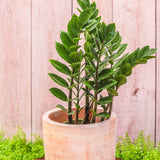

6" Zamioculcas Zamiifolia "ZZ"
Zamioculcas Zamiifolia, commonly known as the ZZ plant, is a popular houseplant known for its glossy, dark green leaves and low-maintenance care requirements. Here’s a detailed guide to caring for your ZZ plant:
1. Light
- Sunlight: ZZ plants thrive in low to bright indirect light. They are very adaptable and can tolerate low light conditions, making them perfect for offices and darker corners of your home.
- Avoid Direct Sunlight: Direct sunlight can scorch the leaves, so it’s best to keep the plant in indirect light.
2. Watering
- Frequency: Water your ZZ plant when the top 1-2 inches of soil are dry. These plants are drought-tolerant and can survive with infrequent watering.
- Method: Water thoroughly until water drains out of the bottom of the pot. Make sure to empty the saucer to prevent the plant from sitting in water.
- Winter: Reduce watering frequency in the winter when the plant's growth slows down.
3. Soil
- Type: Use a well-draining potting mix. A standard houseplant mix or a cactus and succulent mix is suitable. Ensure the soil allows excess water to drain easily.
4. Temperature and Humidity
- Temperature: ZZ plants prefer temperatures between 65-75°F (18-24°C). They can tolerate a range of temperatures but should be kept away from drafts and cold windows.
- Humidity: ZZ plants do well in average household humidity. They are not particularly sensitive to changes in humidity.
5. Fertilizing
- Frequency: Fertilize sparingly. During the growing season (spring and summer), use a balanced, water-soluble fertilizer diluted to half strength once a month.
- Type: A balanced houseplant fertilizer works well.
6. Potting and Repotting
- Pot Choice: Use a pot with drainage holes to prevent waterlogging.
- Repotting: Repot every 2-3 years or when the plant becomes root-bound. Choose a pot that is slightly larger than the current one and refresh the soil.
7. Pruning and Maintenance
- Pruning: ZZ plants require minimal pruning. Remove any yellow or damaged leaves to keep the plant healthy and looking good.
- Cleaning: Wipe the leaves occasionally with a damp cloth to remove dust and allow for better photosynthesis.
8. Pest and Disease Management
-Common Pests: ZZ plants are relatively pest-resistant but can occasionally be affected by pests like spider mites, aphids, and mealybugs. Treat infestations with insecticidal soap or neem oil.
- Diseases: Root rot from overwatering is the most common issue. Ensure proper watering habits and good drainage to prevent this.
9. Propagation
- Methods: ZZ plants can be propagated by leaf cuttings, stem cuttings, or division.
- Leaf Cuttings: Cut a healthy leaf, let it callous over for a day or two, and then plant it in soil.
- Stem Cuttings: Cut a healthy stem, let it callous over, and plant it in soil or water until roots develop.
- Division: When repotting, you can divide the plant by carefully separating the rhizomes and planting them in separate pots.
Additional Tips
- Toxicity: ZZ plants are toxic to pets and humans if ingested, so keep them out of reach of children and pets.
By following these care instructions, your ZZ plant should thrive and continue to be a robust, attractive addition to your indoor space.
Images are used for general reference. Only the size in shape of each plant will vary.
6" Zamioculcas Zamiifolia "ZZ"
- Related products
- Recently viewed

